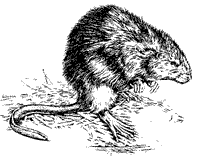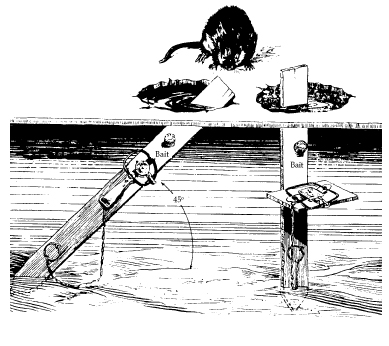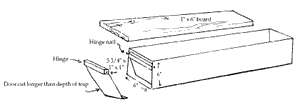How To Fix Muscrat Damage To A Pond Dam
Contents
- ane Impairment Prevention and Control Methods
- 1.1 Exclusion
- 1.2 Cultural Methods and Habitat Modification
- 1.iii Frightening Devices
- i.4 Repellents
- 1.v Toxicants
- 1.6 Fumigants
- 1.7 Trapping
- 1.8 Shooting
- 1.9 Other Methods
- i.ten Summary of Damage Prevention and Control Methods
- 1.11 Exclusion
- 1.12 Cultural Methods and Habitat Modification
- 1.thirteen Frightening
- one.14 Repellents
- 1.xv Toxicants
- 1.sixteen Trapping
- 1.17 Shooting
- 1.18 Other Methods
Damage Prevention and Control Methods
Exclusion

Muskrat, Ondatra zibethicus
Muskrats in some situations can be excluded or prevented from digging into farm swimming dams through stone rip-rapping of the dam. Serious harm often can be prevented, if anticipated, by amalgam dams to the post-obit specifications: the inside face of the dam should be built at a 3-to-1 gradient; the outer face of the dam at a two-to-1 slope with a top width of not less than 8 feet (2.4 m), preferably 10 to 12 feet (iii to 3.6 m). The normal water level in the pond should exist at to the lowest degree 3 feet (91 cm) beneath the tiptop of the dam and the spillway should be broad enough that heavy rainfalls will not increment the level of the water for any length of time (Fig. 5).

Figure five. Proper dam construction tin can reduce muskrat damage to the structure.
These specifications are often referred to equally over-building, only they will by and large forestall serious damage from burrowing muskrats. Other methods of exclusion can include the use of fencing in certain situations where muskrats may be leaving a pond or lake to cut valuable garden plants or crops.
Cultural Methods and Habitat Modification
The best ways to modify habitat are to eliminate aquatic or other suitable foods eaten past muskrats, and where possible, to construct farm swimming dams to previously suggested specifications. If farm pond dams or levees are being damaged, one of the ways that damage can be reduced is to draw the swimming down at least 2 feet (61 cm) beneath normal levels during the winter. Then fill up dens, burrows, and runs and rip-rap the dam with stone. In one case the water is drawn downwardly, trap or otherwise remove all muskrats.
Frightening Devices
Gunfire will frighten muskrats, especially those that get hitting, just information technology is not constructive in scaring the animals away from occupied habitat. No conventional frightening devices are effective.
Back to Top
Repellents
No repellents currently are registered for muskrats, and none are known to be constructive, applied, and environmentally rubber.
Toxicants
The only toxicant federally registered for muskrat control is zinc phosphide as a 63% concentrate. It is a Restricted Use Pesticide for making baits. Zinc phosphide baits for muskrats generally are made by applying a vegetable oil sticker to cubes of apples, sweet potatoes, or carrots; sprinkling on the poisonous substance; and mixing thoroughly. The allurement is then placed on floating platforms (Fig. 6), in burrow entrances, or on feeding houses. Use caution when mixing and applying baits treated with zinc phosphide. Carefully follow instructions on the zinc phosphide container before using.

Effigy six. A allurement platform for decision-making muskrats.
Some states accept obtained state registrations for use of anticoagulant baits such as pivalyl, warfarin, diphacinone, and chlorophacinone. These materials have proven effective, species selective, practical, and environmentally rubber in field applications to control muskrats. Plain there is not sufficient need or research available to consider federal registration of anticoagulants for muskrats. These same first-generation anticoagulants are, however, federally registered for use in command of commensal rodents in and around buildings, and for some use in field situations for rodent command.
Use of the anticoagulant baits, where registered, is in the form of a paraffinized "lollipop" made of grain, pesticide, and melted paraffin. Information technology is placed in burrows or feeding houses. The anticoagulant baits also can be used every bit a grain mixture in floating bait boxes.
Back to Pinnacle
Fumigants
No fumigants are currently registered for muskrat control.
Trapping
In that location have probably been more traps sold for catching muskrats than for catching any other furbearing species. A number of innovative traps have been constructed for both live trapping and killing muskrats, such as barrel, box, and stovepipe traps.

Figure 7. Conibear®-type body-gripping kill trap
The most effective and commonly used types of traps for muskrats, notwithstanding, are the Conibear®-type No. 110 (Fig. 7) and leghold types such equally the long spring No. 1, 1 1/2, or two (Fig. 8) and comparable scroll spring traps. Each blazon has places and situations where ane might be more effective than some other. The Conibear®-type , No. 110 is a preferred choice because it is as effective in vi inches (15 cm) of water and at any deeper level. It kills the muskrat almost instantly, thus preventing escapes. All that is needed to make this set is a trap stake and trap.

Figure 8. Leghold trap.
Muskrats are probably the easiest aquatic furbearer to trap. In most cases where the run or burrow entrance is in 2 feet (61 cm) of water or more than, fifty-fifty a leghold trap requires only a forked stake to make a drowning set. A trap set in the run, the business firm or den entrance, or even under a feeding house, volition usually catch a muskrat in 1 or 2 nights. Equally a test of trap efficiency, this author once gear up 36 Conibear®-type No. 110 traps in a 100-acre (40-ha) rice field and 24 No. 1 i/2 leghold traps in a nearby 60-acre (24-ha) minnow pond on a July twenty-four hours. The next twenty-four hour period 55 muskrats were removed. The remaining traps had not been tripped. Obviously, both of these areas held loftier populations of muskrats and neither had been subjected to recent control efforts. Results were 93.3% effectiveness with the Conibear®-type, 87.5% effectiveness with the leghold traps, and 100% catch per traps tripped.

Figure ix. Four sets for muskrats. Note: All traps are set up under water. Chains are wired to anchors in deep h2o.
The most effective sets are those placed in "runs" or trails where the muskrat'southward hind feet scour out a path into the lesser from repeated trips into and out of the den. These runs or trails tin be seen in articulate water, or tin be felt underwater with easily or feet. Which runs are being used and which are alternate entrances tin can unremarkably be discerned by the compaction of the bottom of the run. Place the trap as close to the den entrance as possible without restricting trap motion (Fig. nine).
Other productive sets are pole sets, under ice sets (Figs. ten and 11), culvert sets. Other traps also can be used effectively in some situations.
Figure 10. Pole set. Figure 11. Nether water ice board sets.


The stovepipe trap (Fig. 12) is very effective in farm ponds, rice fields, and marshes — where it is legal. This type of trap requires more than time and effort to set, but can be very effective if the correct size is used. The trap is cheap, simple, and easy to make; however, to my cognition, information technology is not available commercially. If properly fix in a well-used den entrance, information technology will make multiple catches.

Effigy 12. Stovepipe trap. Note: A length of 5-inch-diameter stove-pipe can be substituted for the side and bottom boards. In this case, the hinged doors must be made U-shaped.
The stovepipe trap has the potential to catch from two to four muskrats on the first night if gear up in the primary den entrance. The trap is cumbersome to behave around, however, and must be staked downwardly properly and set right upwards against the den entrance to exist most constructive. The traps can be hands fabricated from stovepipe, as the name implies, only some of the well-nigh effective versions are variations. An instance is a sheet metallic, 6 x 6-inch (xv x 15-cm) rectangular box, 30 to 36 inches (76 to 91 cm) long with heavy-judge hardware cloth or welded-wire doors. The doors are hinged at the height to allow piece of cake entry from either cease, only no escape out of the box. Decease from drowning occurs in a short time. The trap design besides allows for multiple catches. Its flat bottom works well on most swimming bottoms and in flooded fields or marshes, and it is piece of cake to keep staked downward in place. Such a trap can be made in most subcontract shops in a few minutes. All sets should be checked daily.
Trapping muskrats during the winter furbearer season can exist an enjoyable by-time and fifty-fifty profitable where prices for pelts range from $2.00 to $8.00 each. Price differences depend on whether pelts are sold "in the round" or skinned and stretched. Many people supplement their income by trapping, and muskrats are one of the prime number targets for most beginners learning to trap. Therefore, unless muskrats are causing serious damage, they should exist managed like other wildlife species to provide a sustained annual yield. Unfortunately, when fur prices for muskrats are downwardly to less than $2.00 each, interest in trapping for fur seems to decline. However, in impairment situations, it may exist viable to supplement fur prices to keep populations in cheque.
Dorsum to Peak
Shooting
Where information technology can be done safely, shooting may eliminate one or two individuals in a pocket-sized subcontract pond. Concentrated efforts must be made at dusk and during the first hours of low-cal in the early morning. Muskrats shot in the water rarely can be saved for the pelt and/or meat.
Other Methods
Although a variety of other methods are often employed in trying to command muskrat damage, a combination of trapping and proper use of toxicants is the virtually effective means in most situations. In situations where more all-encompassing damage is occurring, it may be useful to employ an integrated pest management arroyo: (1) modify the habitat past removing available food (vegetation); (2) concentrate efforts to reduce the breeding population during wintertime months while muskrats are concentrated in overwintering habitat; and (3) use both registered toxicants and trapping in combination with the above methods.
There may be other effective methods beyond those already discussed. Some may non be species selective or environmentally prophylactic. Before using whatever control methods for wildlife damage prevention or control, check existing regulations and use tools and methods that do non pose a danger to nontarget species.
Summary of Damage Prevention and Control Methods
Exclusion
Riprap the inside of a pond dam face with stone, or slightly overbuild the dam to sure specifications.
Cultural Methods and Habitat Modification
Eliminate aquatic vegetation as a food source.
Draw down subcontract ponds during the wintertime months.
Frightening
Seldom constructive in decision-making serious harm problems.
Repellents
None are registered.
Toxicants
Zinc phosphide.
Anticoagulants (state registrations only).
Trapping
Trunk-gripping traps (Conibear® No. 110 and others).
Leghold traps, No. ane, ane ane/2, or 2.
Where legal, homemade "stove pipe" traps also are effective when properly used.
Shooting
Effective in eliminating some individuals.
Other Methods
Integrated pest direction.
How To Fix Muscrat Damage To A Pond Dam,
Source: https://wildlife-damage-management.extension.org/muskrat-damage-management/
Posted by: morathipper.blogspot.com


0 Response to "How To Fix Muscrat Damage To A Pond Dam"
Post a Comment